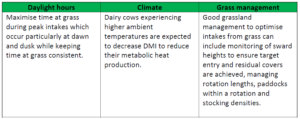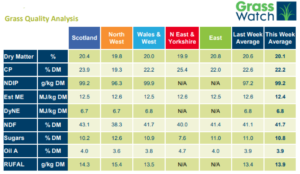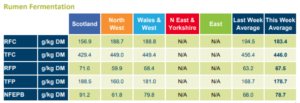Grass Growth
Average grass growth rates for GB at 31.2kg DM/ha/day look to be similar to that seen in 2021 as well as the 6-year average. With temperatures expected to be above average through the month, grass growth rates will hopefully increase versus rates seen in 2021 (Graph below shows 2021 and 6 year average). April 2021 recorded the lowest average minimum temperature for April in the UK since 1922. However, this year, despite warmer averages, unsettled weather is still expected, and it is important to allocate and monitor grass growth on individual farms to support animal performance.
Milk Yield from Grazing (MYFG)
- It is important to highlight that the TNGB laboratory received a limited sample size for reporting NutriOpt and MYFG figures this week.
- Individual farms should analyse their grass to monitor expected performance versus actual performance to allow for the opportunity to optimise management.
- Factors that influence variation away from the expected MYFG can include:
Protein Levels at Grass
- Some regions are experiencing high crude protein levels, such as the Northeast and Yorkshire averaging 25.4%. The lowest crude protein levels were seen in North West at 19%.
- While NutriOpt values are not available for all regions given limited MYFG sample submission, the average NFEPB which indicates the balance of energy to protein is 78.7g/kg DM or 622.44g/day where the target is between 0-200g/day.


How to manage excess protein during grazing
- Offer high energy, low protein concentrate when at grass formulated to NFEPB.
- Use high-quality protein sources to provide high levels of rumen bypass protein (Ultra soy and Ultra pro R).
- Use milk urea’s to identify major energy protein imbalances.
